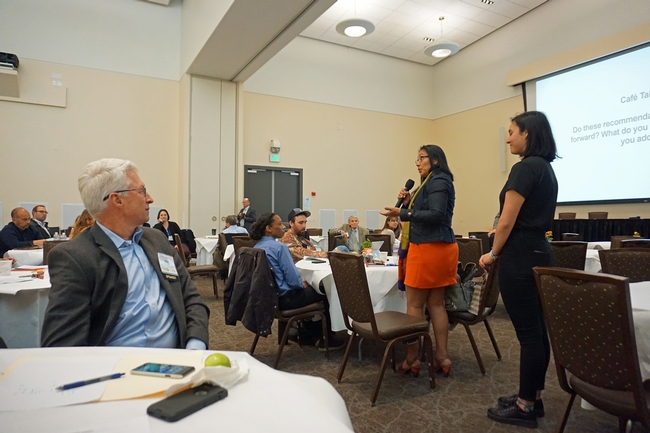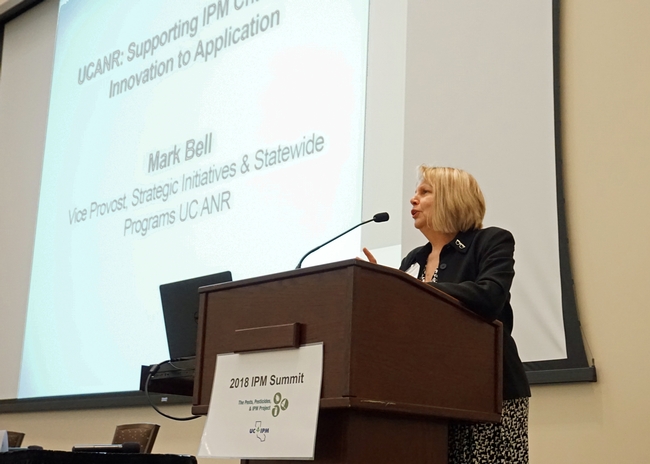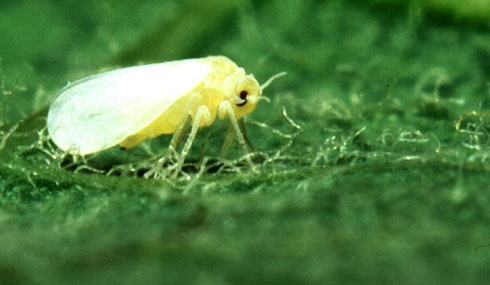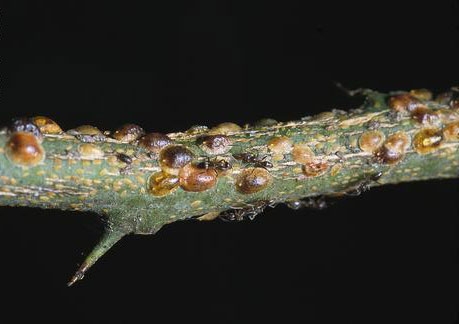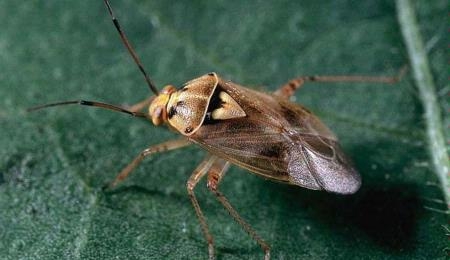Posts Tagged: Pete Goodell
Turning integrated pest management ideas into action
Pests have always been a bane of human existence. Modern society has developed effective pest management, “but there is no kind and gentle way to kill things,” said Brian Leahy, the director of the California Department of Pesticide Regulation, in remarks at the April 2018 IPM Summit.
The ever increasing incidence of invasive pests and the concerns about how to manage them will be a continuing challenge. Leahy said society is on a pest treadmill; and the best way to address it is with integrated pest management (IPM).
The concept of integrated pest management emerged 60 years ago when scientists recognized that imposing a harsh chemical on a natural system threw it off kilter, often causing unexpected, usually negative consequences. They realized that combining an array of pest control methods – such as careful supervision of insect levels, promotion of beneficial insects, and using less harsh products – would be more effective, safer for families and farmworkers, and kinder to the environment in the long run.
And yet, pesticides are still widely used in agricultural, horticultural and structural systems.
“We need to make IPM more robust,” said Pete Goodell, UC IPM advisor emeritus who spent 36 years as an IPM researcher, leader and teacher. “We need to make IPM easier to adopt.”
The meeting in Davis brought together nearly 200 people engaged in the science, business and regulation of pest management. They were assembled to address the tensions around pesticides and their alternatives, and usher in a new generation of researchers and practitioners to maintain and expand on six decades of progress in integrated pest management.
The IPM Summit is the final chapter of a collaborative effort titled “The Pests, Pesticides & IPM Project,” which was funded by DPR to enhance dialog about pest management. The project leader is Lori Berger, UC IPM academic coordinator.
“This project addresses the challenges pests pose to society,” Berger said. “We want to increase adoption of IPM practices on farms, and also in schools, homes, museums and golf courses. We're all in this together.”
One example of urban IPM efforts was presented by the IPM Summit keynote speaker Kelly Middleton, director of community affairs for the Greater Los Angeles County Vector Control District. She outlined the substantial public health concerns associated with pest control in California's largest urban area. A primary target is mosquitos.
“In the early 1900s, vector control started with concerns about malaria and mosquito populations,” Middleton said.
Over decades, the vector control district worked behind the scenes to keep mosquito populations in check. But in recent years, new species of mosquitos capable of spreading Zika, West Nile encephalitis, chikungunya and yellow fever have made their way to LA, intensifying concerns.
A key IPM tool in Los Angeles is minimizing standing water where mosquitos can breed. With year-round water flow irrigating vast landscapes and concrete drainages that inhibit infiltration, the vector district is faced with mosquito breeding grounds created by “urban drool,” Middleton said.
Trash rife with nutrients – such as discarded food and plant materials – are perfect nourishment for immature mosquitos, a condition referred to as “urban gruel.”
Higher temperatures predicted because of climate change only threaten to exacerbate the problem.
“A warming world is a sicker world,” Middleton said.
An effective IPM approach to mosquitos is short-circuiting their reproduction opportunities by enlisting residents to maintain swimming pools, drain any receptacles that can capture rainwater or irrigation, and be vigilant about basins containing water in their environments.
These efforts are emblematic of the societal collaboration that can tackle pest problems without pesticides.
In his IPM Summit presentation, Goodell called for public sector investment in basic research, applied research, extension and education to find IPM solutions and encourage implementation. He appealed for IPM outreach to include community organizations, home owners associations and other non-traditional partners. He suggested agriculture take advantage of farmworkers' presence in the field for early pest detection.
“Technical pest management skills are critical, but it's connections with people that are key to bringing about change,” Goodell said.
UC ANR and San Joaquin Valley cotton growers join forces to prevent sticky cotton in 2015
“It's like having an embarrassing social disease,” Betancourt said. “We want to do better, and we need your help.”
Betancourt was appealing to UC Agriculture and Natural Resources and other experts who were gathered with him at the California Cotton Ginners and Growers Association annual meeting in Visalia. UC ANR entomology specialist Larry Godfrey had begun the pest management session with a somber message. The whiteflies that cotton growers had been controlling reasonably well for more than 20 years was suddenly posing a tremendous challenge.
“I don't know what's up,” said Godfrey, who is housed in the Department of Entomology and Nematology at UC Davis. “It's a different critter.”
Betancourt attested to Godfrey's conclusions. He observed a few whiteflies in the field during the summer of 2013. It was a minor problem. In 2014, he decided to be more aggressive with monitoring and treating for the pest.
“I doubled down last year, but we had a bigger problem with whiteflies,” he said. “I thought, ‘This just can't happen!'”
Whiteflies feed on plant sap and then excrete honeydew. The sweet, sticky honeydew settles on open cotton bolls. If sticky cotton makes its way to spinning mills, it gums up the machinery. It's a scenario that mill managers won't soon forget.
Because of the San Joaquin Valley's long, dry growing season, cotton farmers have earned a reputation for high-quality, high value cotton, said Roger Isom, the CEO of the California Cotton Growers and Ginners Association. Sticky cotton is major concern.
“It happened in Arizona and almost destroyed the state's cotton industry,” Isom said. “Sticky cotton brings mills to a standstill. If they start getting sticky cotton, they'll decide to stop buying from the area where it came from. And once you have the stigma, it's extremely hard to overcome.”
Godfrey said the new biotype of sweet potato whitefly was first found in the San Joaquin Valley in July 1992. Certain areas required careful management, such as those closer to cities where it is warmer and the pest can spend the winter on ornamental plants. Farmers were able to deal with it.
“Then, in 2013 and 2014, populations of whitefly developed in other parts of the San Joaquin Valley, not only adjacent to cities. We don't know why or exactly what is going on,” Godfrey said.
Initially, pest control advisers suspected the whitefly was developing pesticide resistance. UC ANR research trials at the UC West Side Research and Extension Center in Five Points and the Shafter Research Station in Kern County showed that insecticides used at label rates were still able to knock down the pest.
“What we did notice was we had a lot more whitefly and we started seeing them earlier than normal,” Godfrey said. “It certainly makes it more expensive to grow cotton and, if not controlled, makes sticky cotton.”
What's worse, the reputation of cotton in a whole area is tarnished if one or two farmers mismanage the pest and their cotton gets into commercial channels.
“In my area, we have a problem right now and it's not just my problem,” Betancourt said. “Everybody who has whiteflies has to deal with them. We have a reputation to uphold.”
All the growers who send cotton to the same gin as Betancourt will be invited to meet with UC ANR scientists Godfrey and Pete Goodell, integrated pest management advisor, to strategize about whitefly control for 2015.
Godfrey said they will emphasize the importance of early management and treatment, sharing lessons learned in Arizona.
“The scientists there did a lot of really good work on quantifying an infestation and determining when to treat,” Godfrey said. “We are taking their recommendations and studying where we might need to make changes due to California growing conditions.”
Goodell said it is critically important for growers to take the threat of sticky cotton seriously.
“We can't reiterate enough, once you develop a poor reputation for sticky cotton, it sticks with you,” Goodell said.
An initiative to manage endemic and invasive pests and diseases is part of UC Agriculture and Natural Resources Strategic Vision 2025.
Additional resources:
Goodell webinar on Preventing Sticky Cotton.
Godfrey research report PDF attached below:
Management of late-season infestations of cotton aphids and sweet potato whiteflies (strain B) in Pima cotton in the San Joaquin Valley
UC scientists help clarify use of insecticide
The report, Identifying and Managing Critical Uses of Chlorpyrifos in Alfalfa, Almonds, Citrus and Cotton, was commissioned by the California Department of Pesticide Regulation (CDPR) earlier this year and submitted by UC IPM in October 2014.
“We feel the department entrusted UC IPM with this task because of its reputation for developing effective IPM systems and its track record in bringing groups together to address challenging issues,” said Pete Goodell, UC Cooperative Extension advisor for integrated pest management and report principal investigator. Lori Berger, also of the statewide IPM program, was the project coordinator.
To gather input for the report, Goodell and Berger formed four “crop teams” with leaders from the alfalfa, almond, citrus and cotton industries. While chlorpyrifos is used in many of California's more than 300 crops, these four crops were selected due to the amount of acreage treated and insecticide use patterns. Combined, these commodities are grown on about 2.5 million acres and valued at more than $10 billion per year in California.
Chlorpyrifos is a common insecticide used under the trade names Lorsban, Lock-on and generic formulations to control ants, stink bugs, aphids, whiteflies and other pests. The report details the insecticide's use patterns as compared to other pest control tactics, such as resistant varieties, mating disruption, field sanitation and other insecticides.
“Our industry teams told us that chlorpyrifos is an essential component of their IPM programs,” Goodell said. “The teams believe decision support tools would be useful to help pest control advisers and growers recognize the critical use scenarios that require its application.”
As a part of the discussions, the teams asked that CDPR develop comprehensive, science-based information about the specific risk pathways posed by chlorpyrifos and work with the industry to develop any new application safety measures. The representatives of the agricultural community also asked that new human health data from the U.S. Environmental Protection Agency be considered in future CDPR regulatory decision-making to ensure that the most current data available informs their decisions.
For the second phase of the project, UC IPM will hold outreach meetings in 2015 and 2016 for pest control advisers, UCCE farm advisors, commodity group representatives and farmers who grow alfalfa, almonds, citrus and cotton.
“There is a new generation of professionals coming into the field,” Goodell said. “UC's IPM Program is well-prepared to equip them with decision-making tools that include a wide variety of insect management options.”
The full report can be found on the CDPR website: http://cdpr.ca.gov/docs/pestmgt/crit_uses.htm
An initiative to manage endemic and invasive pests and diseases is part of the UC Division of Agriculture and Natural Resources Strategic Vision 2025.
Catching up on UC Cooperative Extension news over the holidays
The Redding Appeal Democrat reported in December that the ranks of U.S. farmers is dwindling. Said Sutter County almond grower Mat Conant, "Pretty soon we'll be such a small minority nobody will listen to us."
Fewer farmers means there are fewer lawmakers with first-hand knowledge of agricultural production.
"You can go to Washington, D.C., and talk about agriculture, but it doesn't have the same impact if you practically experience it," said Christopher Greer, UC Cooperative Extension director for Yuba and Sutter counties.
Lawmakers, like the people they represent, can be lulled into believing that America will always benefit from food costs significantly lower than in Europe, Greer added.
"Everyone gets a little complacent," Greer said. "We expect food to be available at a fairly reasonable price."
Historical Society presents a 'Centennial Celebration'
(Eureka and North Coast) Times-Standard
A meeting at the historical society on Jan. 5 began a year-long celebration of three Humboldt County agricultural organizations that are celebrating 100 years of service in the community: the University of California Cooperative Extension, Humboldt County 4-H Clubs and the Humboldt County Farm Bureau.
Speakers at the event, including Yana Valachovic, UCCE director in Humboldt County, were slated to highlight the roles of each of these organizations in working with youth, commodity producers and the community over the last 100 years. Many events and presentations throughout 2013 will celebrate the local agricultural community.
Far West High Cotton winner committed to finding better ways
Harry Cline, Western Farm Press
Third-generation Merced County farmer Chad Crivelli received this year's Farm Press/Cotton Foundation High Cotton Award for the Western States.
Pete Goodell, UC Cooperative Extension advisor in integrated pest management, was quoted in the Western Farm Press article announcing Crivelli's award.
"Chad meets with people during field trips to share the story about sustainable cotton," Goodell said. "He is a great spokesperson for urban folks who don’t understand what’s going on in cotton industry. He represents the cotton industry incredibly well, and the High Cotton Award is a well-deserved honor for Chad."
Crop issues test Coachella Valley vegetable producers
Cary Blake, Western Farm Press
Jose Aguiar, UC Cooperative Extension advisor in Riverside County, recounted a surprising problem with Coachella Valley peppers in 2012 at the recent Desert Crops Workshop in El Centro.
“This problem threw us for a loop,” Aguiar said. “The bell pepper had a silvering appearance on the fruit exterior. It was not found inside the fruit. It was strictly a cosmetic issue.”
Riverside County is the largest bell pepper producer in California. The Coachella Valley has about 5,000 acres of bell peppers with a farm gate value of about $90 million.
UCCE advisor Richard Smith of Monterey County has found a similar problem in red pepper fields in the Salinas Valley. After testing, Smith’s first guess is the problem could be caused by the fruit rubbing against a branch. There are no holes in the fruit which eliminates the idea of insect damage.
Victor Gibeault named 2013 USGA Green Section Award Recipient
Cybergolf
Victor Gibeault, UC Cooperative Extension specialist emeritist in the UC Riverside Department of Botany and Plant Sciences, received the 2013 USGA Green Section Award in recognition for distinguished service to golf through his work with turfgrass.
"I am both pleased and honored to have been selected to receive the USGA Green Section Award," said Dr. Gibeault. "Now retired, I have been fortunate to spend my career as a University of California Cooperative Extension specialist, and in that role, I have worked on turfgrass research issues and educational projects and programs. My activities with the golf course industry have been enjoyable, fruitful, and have given me a sense of personal accomplishment, for which I am grateful."
Gibeault holds the U.S. patents for two zoysiagrass cultivars, De Anza and Victoria, and one buffalograss cultivar, UC Verde. Additionally he co-edited the 1985 book, "Turfgrass Water Conservation."

A significant number of articles publicized UCCE activities during the winter break.
It takes a village
UC Cooperative Extension researchers are discovering that, for the best control of a pest like lygus bugs, growers should not view their individual farms as isolated islands, reported Cary Blake in Western Farm Press.
“It takes a village to manage lygus,” says Pete Goodell, UC IPM Cooperative Extension advisor with the UC Statewide IPM Program. “Effective lygus management involves landowners, producers, pest control advisers, those with an expertise in biological and physiological issues, and others. Working together across the local landscape is an effective way to effectively manage lygus to reduce its impact in cotton.”
Goodell shared this village mantra during his keynote address at the 3rd International Lygus Symposium held in Scottsdale, Ariz., in late November. More than 80 people attended representing 12 states and five countries.
The article said Goodell and University of Arizona IPM specialist Peter Ellsworth have created a video game that allows producers to collaborate on lygus control. The software predicts lygus outbreaks based on crop placement within a region. Ellsworth and Goodell are seeking funds to get the program into growers' hands.


